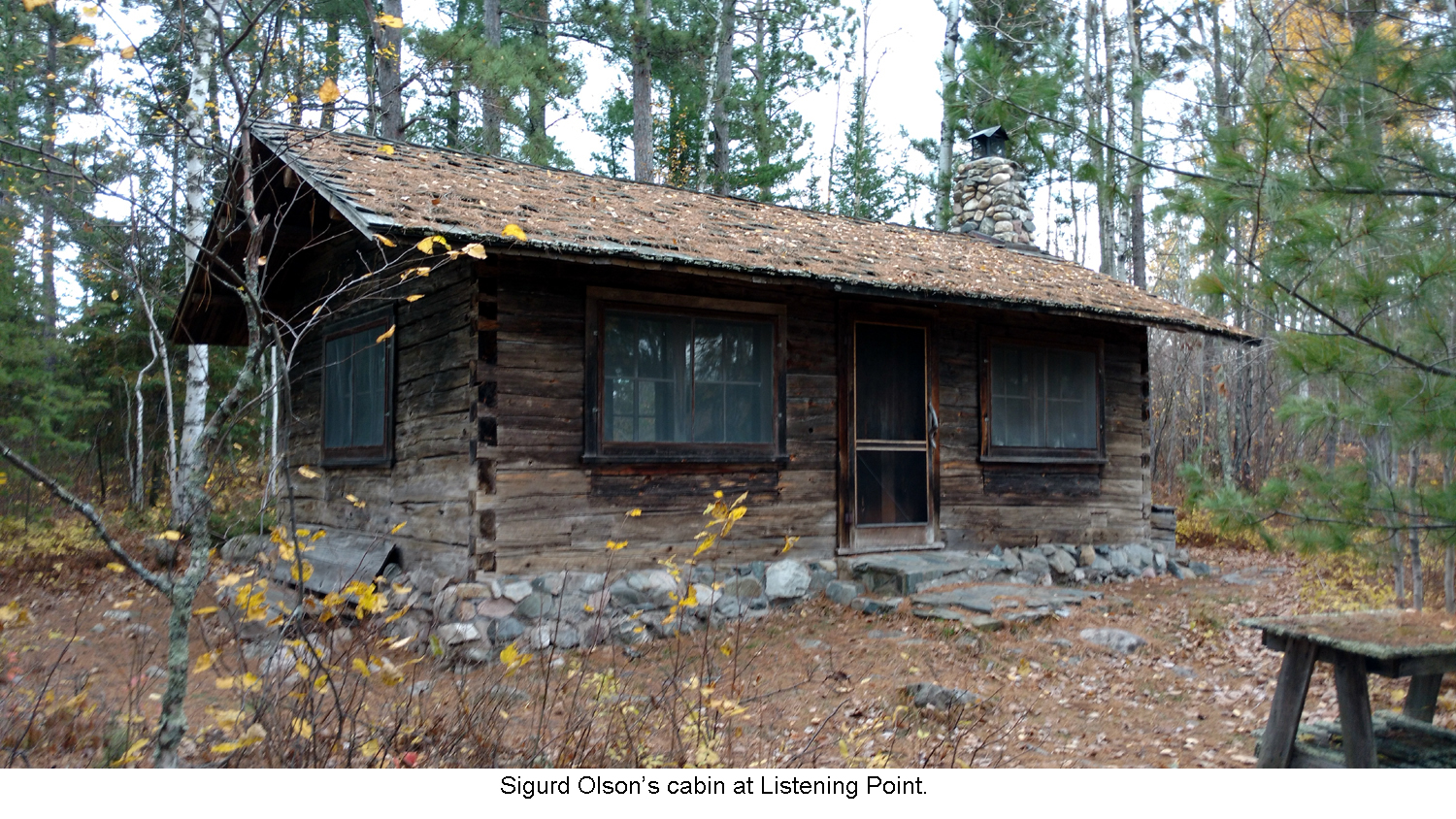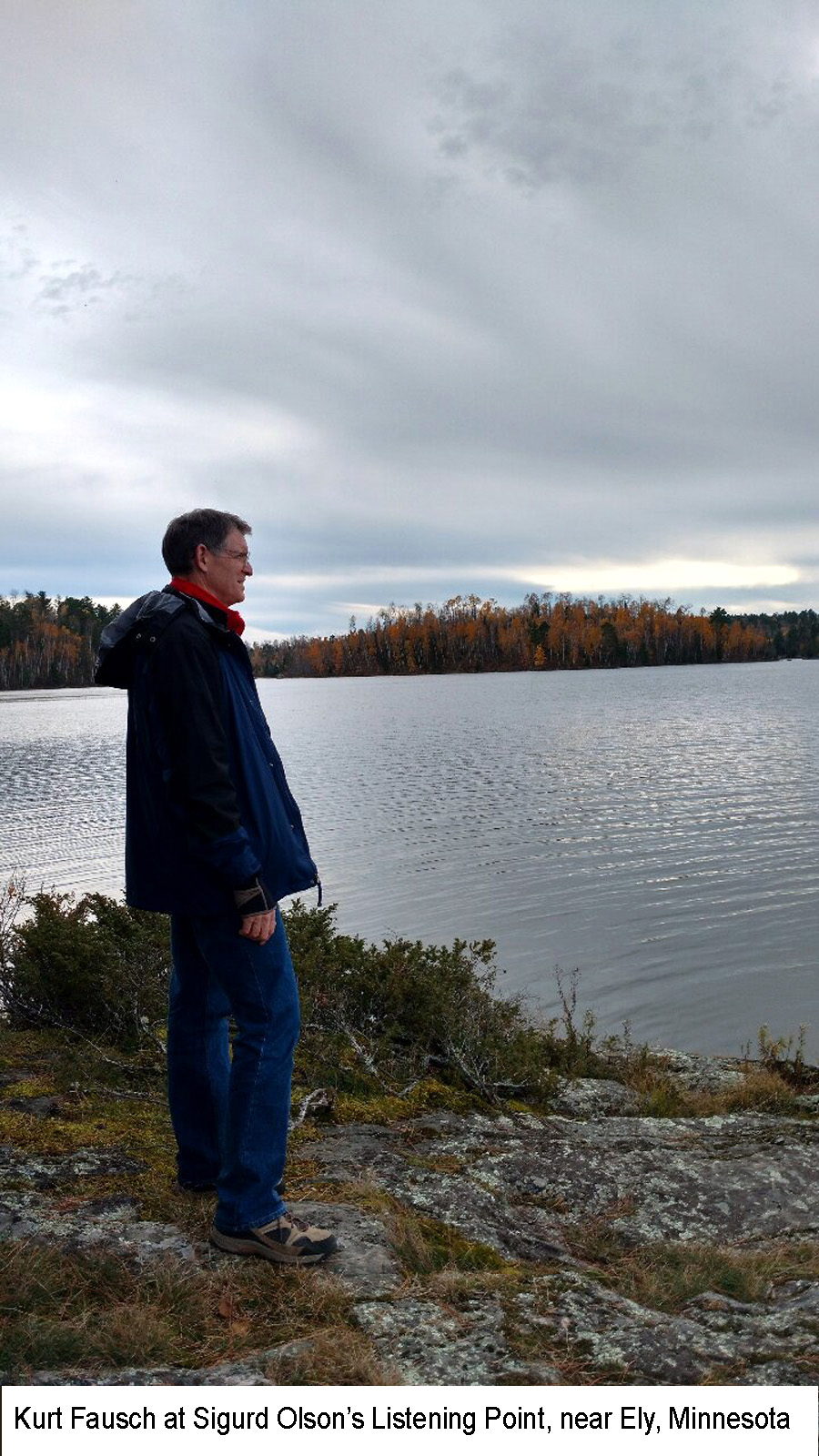
Back in California one year, when I was about 13, I noticed a book on my parents’ shelf titled Listening Point . I had never heard of Sigurd Olson, butI was immediately attracted to the beautiful drawings that graced each chapter heading – pictures of canoes and campsites, loons and portages, and long vistasdown lakes in the border country between northern Minnesota and the vast Canadian Shield to the north. We had visited that country for a week every year, because my father’s sister owned a small cabin perched on the north shore of Lake Superior, a steep, rocky shoreline dashed by waves and shaded closely by spruce and fir. From there we ventured berry picking and fishing in the lakes that bordered the Boundary Waters Canoe Area (BWCA). I fell in love with the cold, crisp air and the stark rocks and waters of this lonely land, so recently scoured by glaciers which left many deep cold lakes, and swift streams tumbling south into the largest lake in the world.
Olson wrote not only of the adventure of canoe trips deep into this wilderness, but also of reverence for this land and these lakes, and why they are important for the human spirit. My first reading of Listening Point , and then other books of his like Runes of the North and The Singing Wilderness, left me entranced with the idea of canoeing in this vast wilderness, traveling along routes plied by voyageurs 300 years earlier. The romance of paddling through these chains of lakes, camping along their shores and fishing in pristine waters led me to work for an entire year at age 15 to earn enough to buy my own canoe. I papered my bedroom wall with the entire set of maps of the BWCA, and pored over the canoe routes through the chains of lakes. I knew that “when I grew up”, I wanted to study fish and become a fisheries biologist. Lakes in northern Minnesota would be the perfect place.

My chance to start this adventure came in 1968. On our way to my aunt’s cabin on “the shore,” we visited the campus of the University of Minnesota in Duluth (UMD), where my older brother was considering attending college. He chose elsewhere, but I knew that Duluth was where I wanted to attend college when I came of age. After my sophomore year at UMD, I landed a summer job as a fisheries biology technician in the BWCA. My partner and I were responsible for surveying the fish and habitat in about 30 different lakes. We spent an entire summer traversing those waterways with boats and canoes, setting nets to sample fish, measuring water chemistry, and mapping shoreline habitat. The next year I did similar work on Lake Superior and several large lakes, focusing primarily on lake trout. I thought I had died and gone to heaven.
And in those same years, I purchased and read all nine of Olson’s books, seeking in his writings a deeper understanding of the history and meaning of this wilderness and its lakes and rivers. In my reading since, I learned that Olson was a contemporary of Aldo Leopold, and indeed turned down a chance for further graduate study with him to earn a Ph.D. Instead, Olson returned to the North Country, taught at a junior college, and focused on advocating for this wilderness and writing essays about its values. He was at the forefront of those who fought to prevent roads to every lake starting in the 1920s, and in the 1940s to prevent aircraft flights that would bring anglers and canoeists deep into the wilderness. He knew from long experience as a canoe guide starting in the early 1920s that this wilderness had great value for the human spirit, but that these values could only be accessed through the hard work of paddling and portaging and camping in primitive places. He saw doctors and businessmen and lawyers and judges transformed from their harried state to people who could appreciate solitude and sunsets, and who pondered again the ancient ideas that only wilderness can evoke.
One day during my senior year in college I attended a talk on wilderness. I recall taking a seat near the back of an auditorium. Looking to the side, I was amazed to see sitting two seats away the man I recognized as Sigurd Olson, a man I would have given anything to talk to. Being rather shy, I didn’t say anything, but felt privileged just to be near him as we both listened to a talk that was probably like many he himself had given. I later realized that Sigurd Olson was in his late seventies then, and passed away six years later, while snowshoeing in the land he loved.
 I now realize that Sigurd Olson’s essays have always been a touchstone for me,
and for the career that I myself have created as a fisheries ecologist. My opportunity to study fish was not in lakes, but in streams, and so I now have a deep love for both. My journey led me throughout much of the West, and to northern Japan. As a scientist, I have seen many rivers, learned their inner workings, and developed a philosophy about why they are essential for humans. But my recent reading of Olson’s early essays on the meaning of wilderness, unavailable to me during my college years, has revealed that he arrived at many of the same ideas far earlier than I. In fact, his idea that modern humans seek habitats like those in which early humans evolved may have formed the basis for some of the theories advanced by other scientists, on which my work is based.
I now realize that Sigurd Olson’s essays have always been a touchstone for me,
and for the career that I myself have created as a fisheries ecologist. My opportunity to study fish was not in lakes, but in streams, and so I now have a deep love for both. My journey led me throughout much of the West, and to northern Japan. As a scientist, I have seen many rivers, learned their inner workings, and developed a philosophy about why they are essential for humans. But my recent reading of Olson’s early essays on the meaning of wilderness, unavailable to me during my college years, has revealed that he arrived at many of the same ideas far earlier than I. In fact, his idea that modern humans seek habitats like those in which early humans evolved may have formed the basis for some of the theories advanced by other scientists, on which my work is based.
On Earth Day 2016, the book I wrote, For the Love of Rivers , was honored with the Sigurd Olson Nature Writing Award. I am still utterly astounded by this. I can’t imagine a higher or more meaningful honor for my work. But only after re-reading Listening Point , and traveling back to Ashland, Wisconsin to speak and receive the award at the Sigurd Olson Environmental Institute at Northland College, did I realize how much the course of my entire career, and my approach to writing this book, were influenced by Olson’s essays and books. I even spent an entire year working with artist Kristine Mackessy to create the pen-and-ink drawings that grace the chapter title pages, showing her the images from Olson’s books as examples of what I sought.
Who knows how what one writes or speaks, or what actions one takes, will affect others? Every professor like me has the chance after a long career to see their legacy through students who were influenced by things they said or did – often not realizing what different messages each person would draw from one’s teaching, writing, or working. Sigurd Olson influenced several generations of people through his best-selling books during an era when the environment came to the fore, and influenced both presidents and policies that conserved many tracts of wilderness, including the BWCA Wilderness. But he also influenced me personally, and for that I am forever grateful. If the book I have written can influence someone else to seek their own path forward and cherish lakes and rivers, especially those in wilderness, then it will have been an amazing success.
©by Kurt D. Fausch, all rights reserved, 27 November 2016
